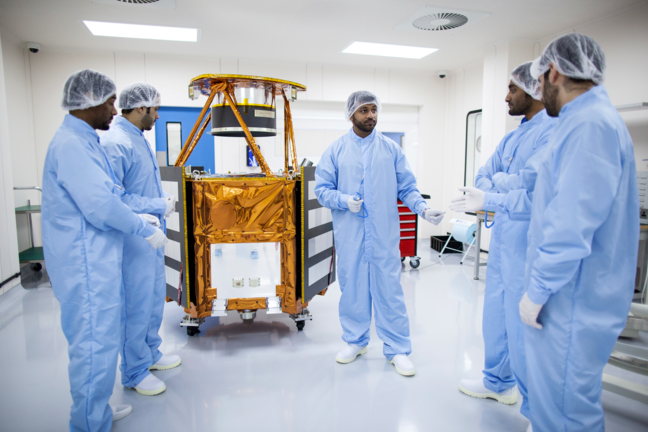The Mohammed Bin Rashid Space Centre has reached a pivotal milestone with the final design of KhalifaSat, the UAE’s landmark satellite built entirely by Emirati engineers. This moment signals not only a technical achievement but a broader stride for national capabilities in space technology, signaling a new era of locally led space exploration, satellite manufacturing, and data-driven applications across disaster relief, urban planning, and environmental stewardship. As the project advances from design to production, the UAE is laying the groundwork for a robust ground infrastructure that will manage all post-launch communications, setting the stage for a future in which Emirati talent and technology drive space initiatives from end to end.
KhalifaSat: Final design milestone and its significance
In a landmark step for the UAE’s space program, the KhalifaSat team completed the final design of the engineering model, marking a major milestone in the ongoing evolution of the nation’s space manufacturing capabilities. This achievement is not only a testament to the satellite’s design and engineering integrity but also a validation of the UAE’s broader strategy to cultivate a fully indigenous space sector. KhalifaSat represents the first time an Emirati satellite has been designed and prepared for manufacture entirely by Emirati engineers, underscoring a shifting paradigm in which local expertise leads and executes complex space technology projects.
This moment underscores the progress of the nation’s satellite manufacturing sector, with the KhalifaSat program serving as a practical, highly visible demonstration of the skills honed through earlier projects. The engineering model’s completion indicates that the knowledge and techniques accumulated across prior initiatives in space technology laboratories have matured into a capable, self-reliant development pipeline. The project’s progression from conceptual design to a finalized engineering model reflects a disciplined approach to systems engineering, hardware integration, and rigorous testing—key components in ensuring mission success for a satellite designed to provide high-resolution imagery and data for critical applications.
At the heart of this milestone is the affirmation that Emirati engineers can lead and execute a complex satellite project. The team’s accomplishment is framed as a direct outcome of leveraging expertise gained from previous Emirates projects, reinforcing confidence in the capabilities of local professionals. KhalifaSat is viewed as the first practical step toward building an Emirati satellite fleet powered by Emirati know-how, with space technology laboratories in Dubai acting as the epicenter of this capability. The success signals a broader capacity-building trajectory that aligns with the UAE’s long-term ambitions to cultivate homegrown innovation in space technologies, spacecraft systems, and mission operations.
The significance extends beyond a single satellite. It demonstrates that UAE institutions can sustain the end-to-end chain of satellite development—from initial design and engineering to assembly, integration, testing, and the preparation of ground support systems. In this context, KhalifaSat represents a blueprint for future projects, where local teams assume leadership roles across all phases of a satellite’s lifecycle, cultivating an ecosystem that supports ongoing research, industrial development, and high-technology jobs within the country.
The final design milestone also acts as a catalyst for the broader aerospace and defense industries in the United Arab Emirates. By showcasing the capability to produce sophisticated space hardware in-country, the KhalifaSat program strengthens the UAE’s reputation as a regional hub for space science and technology. It communicates a clear message to international partners and potential collaborators about the UAE’s seriousness in advancing space exploration, satellite technology, and the development of critical national infrastructure to support science, governance, and public safety.
Alongside the engineering achievement, the project signals the next crucial phase: the transition from design to manufacturing of the actual satellite and the simultaneous development of the ground station systems needed to manage post-launch communications. This dual track—satellite fabrication and ground infrastructure—forms the backbone of KhalifaSat’s operational readiness and is expected to be completed in time to meet the planned launch window and mission objectives. The momentum generated by the final design milestone sustains the confidence of stakeholders in the UAE’s ability to deliver end-to-end, Emirati-led space missions.
The overarching narrative of KhalifaSat’s final design underscores the UAE’s commitment to leveraging space technology for national development. The project’s progress reflects a deliberate, systematic approach to building a self-reliant space sector that can respond to national needs in disaster management, urban development, and environmental protection. It also reinforces the value of high-skill training and hands-on experience for Emirati engineers, scientists, and technicians who will operate and maintain complex space systems and ground networks once KhalifaSat enters service.
Ground station development and post-launch communications
A key component of KhalifaSat’s mission revolves around establishing the ground station programs that will manage all post-launch communications with the satellite. This emphasis on ground infrastructure highlights how the UAE is preparing for sustained data flow from space to Earth, ensuring reliable, timely access to valuable imagery and sensor information for diverse applications. The ground station system will serve as the critical link between KhalifaSat in orbit and the end users who rely on its data for disaster relief planning, urban development, environmental monitoring, and other strategic uses.
The development of ground station capabilities is positioned as a parallel track to satellite production. As the actual satellite approaches readiness for launch, ground station teams will finalize the architecture, software, and operational procedures required to support continuous, long-term operations. This includes establishing communication links with KhalifaSat, configuring uplink and downlink channels, and ensuring robust data handling, storage, and dissemination workflows. The readiness of ground stations is essential to maximize the utility of the satellite’s high-resolution imaging and data products across multiple sectors.
A central objective of the ground station initiative is to enable post-launch control and data management with maximum reliability. This encompasses spacecraft health monitoring, mission operations, and downlink management to minimize data latency and ensure that imagery and geospatial information reach designated centers promptly. The ground system will also support command and control functions, beacon telemetry, and orbit determination activities necessary to maintain KhalifaSat’s operational status. The emphasis on a comprehensive ground network reflects a holistic view of satellite missions, recognizing that success depends not only on the vehicle in space but also on a resilient, integrated ground segment.
To ensure enduring capability, the UAE’s strategy includes deploying multiple ground stations with redundancy, diverse geographic coverage, and secure data handling practices. This approach mitigates risk associated with atmospheric conditions, orbital dynamics, and potential system anomalies. It also enables continuous operation even in the face of localized disturbances, ensuring that critical information can be retrieved, processed, and shared with authorities and partners as needed for timely decision-making.
The ground station development aligns with the broader objective of cultivating a mature, self-sufficient space operations ecosystem within the UAE. By investing in specialized training, software development, and mission planning expertise, the country is building a workforce capable of running complex ground networks long after KhalifaSat’s commissioning. This knowledge transfer and capacity-building effort extend beyond a single mission, equipping engineers and operators with the experience needed to handle future satellites and more complicated missions.
The project’s timeline indicates that the ground station systems and related post-launch communication capabilities are intended to be ready in concert with the satellite’s manufacturing and testing schedule. This synchronization ensures a smooth transition from assembly to launch and, ultimately, to operations. It also fosters organizational readiness, allowing mission control teams to practice, refine procedures, and validate end-to-end workflows ahead of KhalifaSat’s first orbital deployment and data return. The envisioned ground infrastructure will form the backbone of the UAE’s operational satellite framework, capable of supporting KhalifaSat’s mission objectives and future space assets.
The effectiveness of post-launch communications relies on meticulous planning for data downlink capacity, ground network management, and data processing pipelines. The ground stations will handle vast streams of imagery and sensor data, requiring sophisticated data compression, transmission, and storage solutions to ensure that high-resolution data remains accessible to end users. Additionally, secure communication protocols and rigorous cyber protection measures will be integral to safeguarding sensitive information against potential threats, reinforcing the integrity of the mission’s data lifecycle.
In summary, KhalifaSat’s ground station development represents a crucial, interdependent element of the mission architecture. The success of the satellite in orbit will be contingent upon a robust, well-designed ground network capable of reliable post-launch communication, data handling, and operational control. The UAE’s approach to building this infrastructure in parallel with satellite production demonstrates a mature, forward-looking strategy designed to maximize the impact and longevity of KhalifaSat and to pave the way for future Emirati space endeavors.
UAE space program: progress, capabilities, and legacy
KhalifaSat’s final design milestone sits within a broader narrative of the United Arab Emirates’ ongoing ascent in space technology and exploration. The project follows earlier UAE launches of remote sensing satellites and illustrates a sustained commitment to developing an independent, homegrown space program. The Emirates’ trajectory reflects a deliberate effort to expand national capabilities beyond basic participation to leadership in space system development, including the design, manufacture, and operation of satellites by Emirati engineers.
The UAE’s track record includes successful launches of two remote sensing satellites, DubaiSat 1 and DubaiSat 2. These earlier missions established a foundation for the nation’s space ambitions, demonstrating the country’s capacity to contribute to satellite technology and to apply space-derived data for practical applications. The KhalifaSat program builds on this foundation by pushing toward a more advanced class of satellites and advancing the end-to-end ownership of missions—from concept to deployment and operations.
The KhalifaSat program reinforces the UAE’s strategic approach to space that emphasizes in-country capability building and local ownership. By positioning Emirati engineers at the helm of a satellite designed, assembled, and planned for operations within the UAE, the project strengthens national confidence in the potential of local talent to drive high-technology initiatives. This strategy aligns with broader national goals to diversify the economy, accelerate scientific research, and cultivate robust STEM pipelines that produce skilled engineers, technicians, and project managers who can contribute to space, aerospace, and related industries.
In reinforcing its capability, the UAE emphasizes the importance of a sustainable space sector that can deliver real-world benefits. The KhalifaSat mission holds promise for disaster relief management, where timely, high-resolution imagery can support responders in planning and executing relief operations. Urban planning and environmental protection are other critical areas where satellite data can inform policy decisions, support infrastructure development, monitor environmental changes, and enable more informed governance. By investing in such capabilities, the UAE seeks to translate space technology into concrete public benefits, strengthening resilience, efficiency, and strategic planning across multiple domains.
The KhalifaSat project also signals the value of regional and international collaboration. While the UAE is showcasing in-country expertise, successful space programs typically benefit from partnerships with established space-faring nations and industry leaders. The H-IIA launch vehicle, built by Mitsubishi Heavy Industries, represents a collaboration with a globally recognized launch system provider, underscoring how international partnerships can complement domestic development. This combination of local leadership and international collaboration positions KhalifaSat within a network of global space activities, enabling knowledge exchange, technology transfer, and shared learning that can accelerate the UAE’s pace of innovation.
From an educational and workforce development perspective, KhalifaSat is expected to serve as a catalyst for high-skill training and career advancement in the UAE. The involvement of Emirati engineers across all phases of the mission—from concept and design to system integration, testing, and ground segment development—helps cultivate a generation of professionals capable of carrying forward increasingly ambitious space projects. The program’s emphasis on hands-on experience within Space Technology Laboratories in Dubai further strengthens the nation’s capacity to sustain and scale future missions, ensuring that the benefits of space technology extend to broader sectors and industries.
The mission’s long-term impact extends to science, technology, and innovation ecosystems in the UAE. By nurturing a culture of engineering excellence, problem-solving, and cross-disciplinary collaboration, KhalifaSat contributes to a broader national strategy to position the UAE as a knowledge-based economy with a strong footprint in space science and technology. The program’s success creates a blueprint for future projects, encouraging continued investment in research and development, strengthening intellectual property pipelines, and supporting startup and industrial activity in related fields such as robotics, data analytics, aerospace engineering, and satellite-enabled services.
In light of these developments, KhalifaSat stands as a symbol of national ambition and capability. It embodies the UAE’s commitment to building a self-reliant space sector, where technology originates from in-country design and production processes, and where end-to-end mission operations are led by Emirati professionals. The project’s milestones—design finalization, ground station readiness, and the forthcoming manufacturing and launch—collectively convey a compelling narrative about the UAE’s readiness to contribute meaningfully to global space exploration, science, and practical applications that benefit communities at home and around the world.
Timeline and production milestones: from design to launch
The KhalifaSat program follows a carefully planned sequence of milestones designed to ensure timely progress toward a successful launch. The completion of the final design for the engineering model marks the transition from planning to tangible construction, signaling that the core subsystem interfaces, architectures, and integration plans are validated and ready for subsequent production steps. This milestone lays the groundwork for moving into the fabrication phase, where the actual satellite will be built according to the approved design data and rigorous engineering standards. The emphasis on a complete and accurate engineering model underscores the importance of thorough verification and validation before proceeding to manufacturing, assembly, and testing.
As the project advances, the development of the ground station systems is pursued in parallel with satellite production. This dual-track approach ensures that, once KhalifaSat is assembled and tested, the ground segment will be ready to establish communications, coordinate mission operations, and facilitate data downlink without delay. The synchronization of satellite manufacturing with ground infrastructure readiness is essential to minimize schedule risk and to maximize mission readiness on launch day.
The planned timeline indicates that the actual satellite manufacturing and the development of the ground station systems are expected to be completed in time to align with the 2017 target for readiness ahead of the intended 2018 launch. Meeting this window would reflect effective project management, robust supply chain coordination, and rigorous testing protocols that validate system performance under realistic operating conditions. It would also demonstrate the team’s ability to anticipate potential challenges and implement mitigations to keep the project on track.
In addition to hardware production, the KhalifaSat program emphasizes software, data handling, and mission operations readiness. Ground segment software must be developed, tested, and validated to support commands, telemetry, and data processing workflows. This includes implementing robust mission control procedures, ensuring secure communications, and validating end-to-end data pipelines from satellite downlink to end-user dissemination. The integration of software and hardware components is a critical aspect of the program, ensuring that the satellite can be controlled effectively and that the data it collects can be transformed into actionable information for end users.
The timeline also encompasses training and capacity-building activities for Emirati engineers and operators who will manage KhalifaSat’s mission. Equipping personnel with the skills needed for operations planning, anomaly handling, and routine maintenance is essential for the long-term sustainability of the UAE’s space program. This focus on knowledge transfer ensures that the human capital aspect of the mission remains strong, enabling continued leadership in future missions and ongoing support for ground station operations and data analysis.
The project’s milestones are designed to culminate in a launch window during 2018, with the H-IIA launch vehicle as the carrier. Achieving this objective would validate the UAE’s ability to manage a complex, end-to-end space project—from initial design through to deployment and operations—potentially opening doors for additional collaborations, missions, and capabilities in the years ahead. Success would also reinforce confidence in the UAE’s domestic manufacturing base, ground systems, and workforce readiness, while illustrating the tangible benefits of sustained investment in space technology and related industries.
EIAST history: DubaiSat 1 and DubaiSat 2 as precursors
The KhalifaSat project follows in the footsteps of earlier UAE space endeavors led by EIAST, which has launched two remote sensing satellites—DubaiSat 1 and DubaiSat 2. These earlier missions established a track record of UAE capability in space technology and demonstrated the country’s commitment to developing an independent space program. The experience gained from DubaiSat 1 and DubaiSat 2 provided valuable foundations for the KhalifaSat initiative, enabling the country to refine its design, manufacturing, testing, and mission operations practices while building a domestic talent pool.
DubaiSat 1 and DubaiSat 2 served as practical testbeds for Emirati engineers to apply their knowledge to real-world satellite platforms. The successful launches and ongoing operations of these satellites helped validate the UAE’s approach to space technology development and cultivated a broader ecosystem for space-related research, industry collaboration, and educational opportunities. The experiences from these prior missions informed the KhalifaSat program’s strategies, including how to manage complex integration challenges, coordinate with international partners, and navigate the regulatory and logistical aspects of space missions.
The continuity from DubaiSat projects to KhalifaSat reflects a deliberate progression in the UAE’s space portfolio. Each mission builds on lessons learned, enabling incremental improvements in design philosophies, testing methodologies, and operational procedures. This progression strengthens the UAE’s reputation in the international space community as a reliable partner capable of delivering high-quality, in-country-built space systems. It also reinforces the value of long-term planning and sustained investment in space technology to realize a broader set of national objectives.
The DubaiSat lineage demonstrates that the UAE is not merely participating in space from the sidelines but actively shaping the way space systems are conceived, built, and utilized for public benefit. Each successive mission contributes to a deeper understanding of satellite capabilities, sensor technologies, data processing, and the practical applications of space-derived information in governance, planning, and resilience. KhalifaSat, as the next step in this continuum, embodies the expansion of Emirati leadership in space engineering and mission operations, signaling a continued commitment to advancing the domestic space sector through ambitious, capability-rich projects.
Implications for disaster relief, urban planning, and environmental protection
KhalifaSat’s stated mission is to provide high-resolution imagery and data that can support disaster relief management, urban planning, and environmental protection, among other uses. The satellite’s data products have the potential to enhance decision-making processes in times of crisis, enabling authorities to assess damage, allocate resources, and coordinate response efforts with greater precision and speed. In urban planning contexts, timely, detailed imagery supports land-use analysis, infrastructure planning, and monitoring of rapid urban growth, helping planners identify needs, optimize services, and inform policy decisions. Environmental protection applications may include monitoring natural resources, tracking changes in ecosystems, and supporting climate-related research through accurate geospatial data.
The ability to deliver high-quality imagery and other data from KhalifaSat could enable a range of practical outcomes for national and regional stakeholders. Disaster relief agencies could use satellite imagery to map affected areas, guide relief operations, and monitor recovery progress over time. Environmental agencies could deploy data to monitor land degradation, water resources, and air quality indicators, contributing to evidence-based environmental management strategies. Urban planning bodies could rely on up-to-date imagery to inform zoning decisions, infrastructure investments, and resilience planning, ensuring that cities can grow in a sustainable and well-supported manner.
Achieving these benefits requires not only advanced satellite hardware but also robust data processing, dissemination, and applications development. The KhalifaSat program’s emphasis on end-to-end capability—from design to data delivery—ensures that imagery and data products can be integrated into decision-support workflows. It also highlights the importance of building a domestic ecosystem that includes data analytics, geospatial information systems (GIS), and user-focused services that translate raw satellite data into actionable insights for policymakers, responders, and the public.
This approach aligns with a broader vision in which space technology serves public interests and contributes to national resilience. By investing in a satellite capable of delivering timely, high-resolution data, the UAE reinforces its ability to respond to natural and man-made events with improved situational awareness and evidence-based planning. The mission’s data outputs could inform a wide range of activities, from emergency response and risk assessment to infrastructure maintenance and environmental monitoring, underscoring the practical value of space technology in everyday governance and crisis management.
The KhalifaSat program thus stands as a case study in how a national space initiative can translate scientific and engineering prowess into tangible public benefits. It demonstrates that a locally designed and produced satellite, supported by a capable ground segment and data-processing infrastructure, can contribute to national priorities across multiple sectors. The project’s trajectory suggests opportunities for continued growth in data-driven services, cross-sector collaboration, and the development of local expertise that can sustain and enhance the UAE’s role in space-based innovation.
Conclusion
The final design of KhalifaSat marks a watershed moment for the UAE’s space program, signaling a shift toward fully Emirati-led satellite development and a robust, end-to-end space capability. The project’s progress—from a finalized engineering model to the next phases of actual satellite fabrication and ground system development—reflects a deliberate strategy to build in-country expertise, manufacturing capacity, and mission operations proficiency. The initiative builds on the UAE’s prior successes with DubaiSat 1 and DubaiSat 2, reinforcing national confidence in the ability to deliver sophisticated space technologies and to leverage space-derived data for disaster relief, urban planning, and environmental protection.
Ground station development accompanies satellite production, reinforcing the importance of reliable post-launch communications and data handling. By establishing a comprehensive ground infrastructure and rigorous operational procedures, the UAE aims to ensure seamless command, telemetry, and data downlink processes that can support mission success and maximize the value of KhalifaSat’s high-resolution imagery. The program’s broader context highlights how Emirati engineers are shaping a resilient, future-ready space ecosystem—one that fuses in-country design and construction with strategic international partnerships to advance national capabilities and foster a thriving hub of space science, technology, and innovation.
Ultimately, KhalifaSat embodies the UAE’s ambition to harness space technology for the public good. Its design finalization, coupled with the development of ground station systems and a plan for rapid production and launch readiness, signals a sustained commitment to advancing space capabilities, uplifting local expertise, and delivering tangible benefits for disaster response, urban development, and environmental stewardship. As the project progresses toward the anticipated 2017–2018 milestones, it stands as a testament to a focused national strategy: to build world-class space technology in the UAE, empowering Emirati engineers to lead the way in space exploration and its practical applications for years to come.



